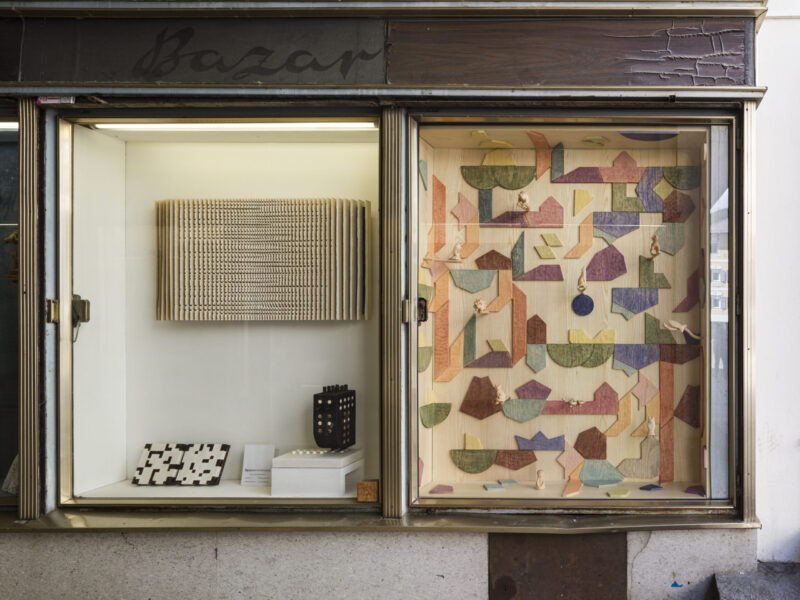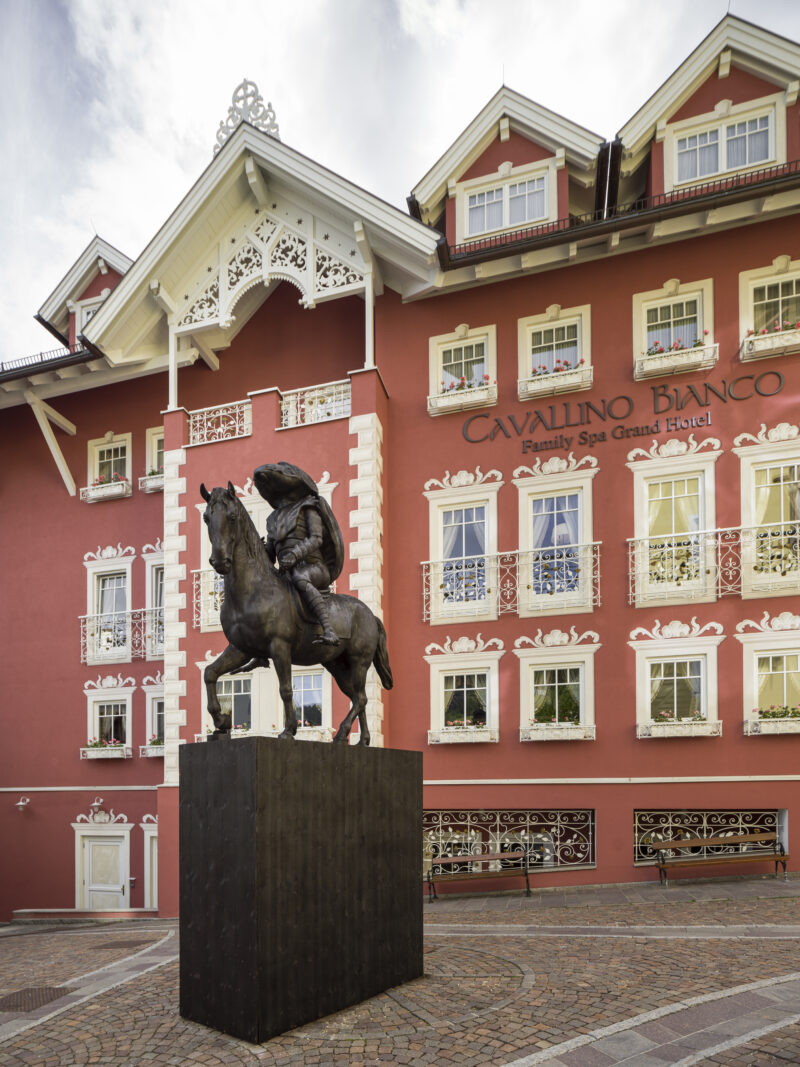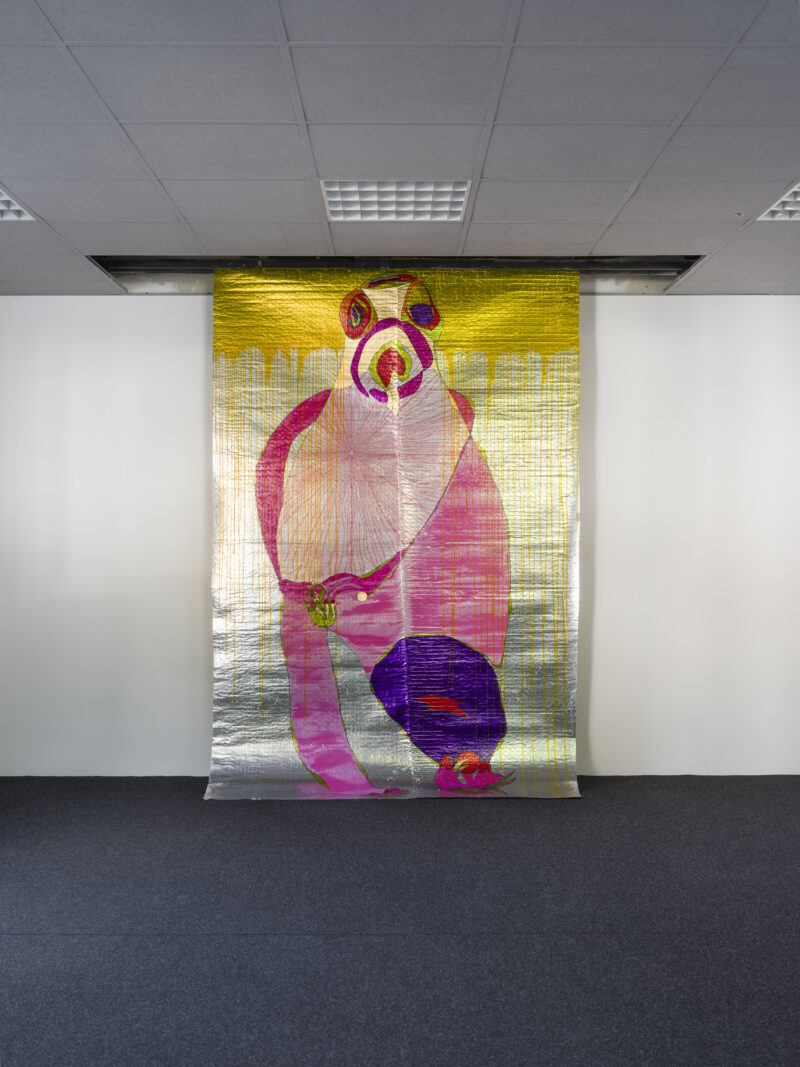by Adela Lovric // Aug. 15, 2024
Since 2008, Biennale Gherdëina—originally a fringe event of MANIFESTA 7, founded by Doris Ghetta in Ortisei and inspired by the ethos of the nomadic biennial—has steadily grown into its own. For this year’s ninth edition, curated by Lorenzo Giusti and associate curator Marta Papini, contributions from over 30 artists (among them 19 new commissions) are set against the stunning backdrop of the Dolomites, a UNESCO World Heritage Site in the northern Italian Alps. Echoing anthropologist Anna Tsing’s idea of contamination—a metaphor primarily standing in for diverse social interactions that lead to transformation through encounter—artworks temporarily inhabit Ortisei and the surrounding area, which has been tamed by tradition and a tightly managed system catering to tourists. Engaging with the location and its traditions of woodworking, storytelling and hiking, artists from Europe and the MENA region reflect on the ecologies, histories and legacies of the area and the nuanced wider context of the Mediterranean.

Sara Ouhaddou: ‘Les mains fertiles – Fertile hands,’ 2024, Commissioned by Biennale Gherdëina 9 // Photo by Tiberio Sorvillo
In the center of Ortisei, for instance, passersby may encounter works by Sara Ouhaddou and Julius von Bismarck that draw on the local wood sculpture tradition to address broader themes. Ouhaddou’s installation ‘Fertile Hands’ (2024), created in collaboration with Helene Demetz, is showcased in a shop window typically reserved for religious or nature-themed sculptures created by the town’s skilled woodworkers. Rooted in the ancient art of Val Gardena, the piece also takes inspiration from the Berber poet Mririda N’Ait Attik. It represents animals native to Val Gardena and builds a connection with Moroccan zoomorphic pottery, a practice dating back to the Neolithic period. Mirroring figurines typically used as toys or amulets for children, ‘Fertile Hands’ subtly weaves a tradition from the Atlas Mountains into the Alpine context.
In contrast to Ouhaddou’s inconspicuous artistic interpolation, von Bismarck’s ‘Beetle on a Horse’ (2024) boldly takes up space on the main street. A twist on the Western tradition of glorifying rulers, the large equestrian statue made of wood features a bark beetle as the conqueror on a horseback. Certain species of this insect are especially invasive, developing large populations that drain healthy trees of life. Fuelled by global warming and human neglect, they have decimated vast woodland areas in the Dolomites. By removing the human figure from the pedestal and mounting a human-sized version of the small pest in its place, the artist directs attention to the destructive forces affecting the environment and the place of both humans and other species in them.

Julius von Bismarck: ‘Beetle On A Horse,’ 2024, Commissioned by Biennale Gherdëina 9, Supported by IFA – Institut für Auslandsbeziehungen // Photo by Tiberio Sorvillo
The biennial’s curatorial concept ties trans-geographical mountain narratives with the ideas of multi-speciesism as path-makers for the future, as well as multiple (and even contradictory) considerations of the wild. It creates a link between bordered and seemingly disconnected parts of the world, but even more so, brings up the existential notion that humans are not the only protagonists on Earth. While this has been an ongoing concern of curators interested in posthumanism, Giusti and Papini consider it in relation to the legend of the Fanes, an ancient Ladin myth of the Dolomites, reconstructed at the beginning of the 20th century by Karl Felix Wolff. The story recounts a peaceful kingdom that thrived due to its alliance with marmots, the so-called sentinels of the Alps. According to legend, misfortune struck when a princess, ashamed of Fanes’ pact with the mountain critters, rejected this alliance, leading to the kingdom’s downfall with few survivors still awaiting its glorious return.
While reconstructing this ancient tale, Wolff heavily relied on Nordic mythology, which was prevalent in the culture of his time and aligned with the Austro-Hungarian imperial narrative. In doing so, he overlooked the deep connections these stories had with ancient Mediterranean traditions—connections that the curators were dedicated to bringing forth in this biennial edition, along with parallels to today’s repeatedly broken pact between humans and other living beings. Taken from the name of a plateau in the Fanes Alps, ‘The Parliament of Marmots’ as an exhibition title neatly ties together the biennial’s site with the current contemplations about de-centering humans in favor of honoring more-than-human life.

Atelier dell’Errore: ‘Marmottoloide,’ 2024, Commissioned by Biennale Gherdëina 9 // Photo by Tiberio Sorvillo
Nowadays, marmots are the unwilling subjects of a real crisis scenario: their population is steadily declining due to climate-induced changes in the Alps, which are warming at a rate faster than much of the planet. At Biennale Gherdëina Office in Pontives, Atelier dell’Errore counters this predicament in their series of works titled ‘Marmottoloide’ (2024) by depicting the adorable but fierce Alpine rodent with a sense of playfulness and hope. The 11 members of the neurodivergent artist collective regularly create animal-themed works and, for this show, divine marmot-like creatures with punk attributes took centerstage on their small to large scale drawings.
Expanding a hopeful focus on animals, an exhibition of works by Lin May Saeed at Sala Trenker in Ortisei pays tribute to the late sculptor and animal rights activist. Saeed’s often fragile-looking polystyrene sculptures and reliefs, drawings, cut-paper silhouettes and installations are born from a vision of a peaceful coexistence between humans and animals, bound by reconciliation and friendship. Drawing on myths, fairytales and legends, these artworks act as images of a possible common future, conducting a spiritual charge through their airy physical presence. The retrospective, presented in two parts through a shared exhibition itinerary, is concurrently on view at the GAMeC in Bergamo.

‘Tribute to Lin May Saeed, Works 2006 – 2023,’ Realized by GAMeC, Bergamo in Collaboration with Biennale Gherdëina 9 // Courtesy of The Estate of Lin May Saeed and Jacky Strenz, Frankfurt/Main; Photo by Tiberio Sorvillo
This year, the biennial once again looks into the Dolomites’ fascinating primordial past, provoking the audience to feel small and fleeting in the bigger scale of time and space. The 250-million-year-old mountains were once an enormous coral reef, formed by organisms and sediments in a tropical ocean, hardened with deposits of volcanic material, and lifted as the African continental plate had approached the European plate. Ingela Ihrman’s ‘First Came the Ocean’ (2024), a large-scale installation embedded in the mountain landscape, on a meadow that was once the seabed, is by far the most striking artwork dealing with this theme—partly due to the breathtaking views that surround it. The artist sourced trunks and branches of trees that have fallen victim to the bark beetle epidemic, to recreate a gigantic skeleton of a marine animal that inhabited the primordial ocean where today’s mountain range emerged.

Ingela Ihrman: ‘First Came the Ocean,’ 2024, Commissioned by Biennale Gherdëina 9 // Photo by Tiberio Sorvillo
Beyond the impressive location and the site-specific artworks that are cleverly entangled in its many connecting strings, among the most interesting aspects of this biennial are the ways in which commissioned artists engaged with the curator’s well-developed concept, as well as how their works resonated with the works of other participating artists. The curators’ convivial and attentive interactions with artists, visitors and enthusiastic locals (who were eager to celebrate the biennial’s return to their community) spoke volumes about the integrity of this recurring event. As a returning visitor, having first experienced the 2022 edition curated by Lucia Pietroiusti and Filipa Ramos, the biennial’s future iterations bring a new level of excitement and anticipation, set in motion by this year’s curators and their predecessors.
Exhibition Info
Biennale Gherdëina
Exhibition: May 31-Sept. 1, 2024
biennalegherdeina.it
Various Venues



















